The US State Department announced on Wednesday that it has charged aerospace firms Boeing and Hughes with 123 violations of illegally sharing space technology with China. If the charges are upheld, the two companies could face up to $60 million in fines, and be prohibited from selling “controlled technologies” to other countries. The two companies say they did nothing wrong, and have already been fighting these allegations for several years.
Hubble Images the Little Ghost Nebula
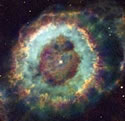
Image credit: Hubble
The latest image release from the Hubble Space Telescope is of the “Little Ghost Nebula”; a.k.a. NGC 6369, located several thousand light years from Earth in the constellation of Ophiuchus. The nebula was created when a star like our own Sun entered the final stages of its life and expelled its outer layers into space. The glow is caused by the ultraviolet light streaming from the star and heating up the surrounding gas and dust.
NASA’s Hubble Space Telescope has recently obtained images of the planetary nebula NGC 6369. This object is known to amateur astronomers as the “Little Ghost Nebula,” because it appears as a small, ghostly cloud surrounding the faint, dying central star. NGC 6369 lies in the direction of the constellation Ophiuchus, at a distance estimated to be between about 2,000 and 5,000 light-years from Earth.
When a star with a mass similar to that of our own Sun nears the end of its lifetime, it expands in size to become a red giant. The red-giant stage ends when the star expels its outer layers into space, producing a faintly glowing nebula. Astronomers call such an object a planetary nebula, because its round shape resembles that of a planet when viewed with a small telescope.
The Hubble photograph of NGC 6369, captured with the Wide Field Planetary Camera 2 (WFPC2) in February 2002, reveals remarkable details of the ejection process that are not visible from ground-based telescopes because of the blurring produced by the Earth’s atmosphere.
The remnant stellar core in the center is now sending out a flood of ultraviolet (UV) light into the surrounding gas. The prominent blue-green ring, nearly a light-year in diameter, marks the location where the energetic UV light has stripped electrons off of atoms in the gas. This process is called ionization. In the redder gas at larger distances from the star, where the UV light is less intense, the ionization process is less advanced. Even farther outside the main body of the nebula, one can see fainter wisps of gas that were lost from the star at the beginning of the ejection process.
The color image has been produced by combining WFPC2 pictures taken through filters that isolate light emitted by three different chemical elements with different degrees of ionization. The doughnut-shaped blue-green ring represents light from ionized oxygen atoms that have lost two electrons (blue) and from hydrogen atoms that have lost their single electrons (green). Red marks emission from nitrogen atoms that have lost only one electron.
Our own Sun may eject a similar nebula, but not for another 5 billion years. The gas will expand away from the star at about 15 miles per second, dissipating into interstellar space after some 10,000 years. After that, the remnant stellar ember in the center will gradually cool off for billions of years as a tiny white dwarf star, and eventually wink out.
Original Source: Hubble News Release
XMM Helps Uncover Exotic Matter
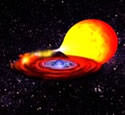
Image credit: ESA
Shortly after the Big Bang, it’s believed that all the matter in the Universe was broken up into its smallest components. But astronomers believe that some of this original material may be created again inside very dense neutron starts. Using the XMM-Newton space telescope, a team of astronomers are attempting to calculate the “compactness” of several neutron stars – to see if they go beyond the density of normal matter.
A fraction of a second after the Big Bang, all the primordial soup of matter in the Universe was ‘broken’ into its most fundamental constituents. It was thought to have disappeared forever. However scientists strongly suspect that the exotic soup of dissolved matter can still be found in today’s Universe, in the core of certain very dense objects called neutron stars.
With ESA’s space telescope XMM-Newton, they are now closer to testing this idea. For the first time, XMM-Newton has been able to measure the influence of the gravitational field of a neutron star on the light it emits. This measurement provides much better insight into these objects.
Neutron stars are among the densest objects in the Universe. They pack the mass of the sun inside a sphere 10 kilometres across. A sugar cube-sized piece of neutron star weighs over a billion tonnes. Neutron stars are the remnants of exploding stars up to eight times more massive than our Sun. They end their life in a supernova explosion and then collapse under their own gravity. Their interiors may therefore contain a very exotic form of matter.
Scientists believe that in a neutron star, the density and the temperatures are similar to those existing a fraction of a second after the Big Bang. They assume that when matter is tightly packed as it is in a neutron star, it goes through important changes. Protons, electrons, and neutrons ? the components of atoms – fuse together. It is possible that even the building-blocks of protons and neutrons, the so-called quarks, get crushed together, giving rise to a kind of exotic plasma of ‘dissolved’ matter.
How to find out? Scientists have spent decades trying to identify the nature of matter in neutron stars. To do this, they need to know some important parameters very precisely: if you know a star?s mass and radius, or the relationship between them, you can obtain its compactness. However, no instrument has been advanced enough to perform the measurements needed, until now. Thanks to ESA’s XMM-Newton observatory, astronomers have been able for the first time to measure the mass-to-radius ratio of a neutron star and obtain the first clues to its composition. These suggest that the neutron star contains normal, non-exotic matter, although they are not conclusive. The authors say this is a ?key first step? and they will keep on with the search.
The way they got this measurement is a first in astronomical observations and it is considered a huge achievement. The method consists of determining the compactness of the neutron star in an indirect way. The gravitational pull of a neutron star is immense – thousands of million times stronger than the Earth?s. This makes the light particles emitted by the neutron star lose energy. This energy loss is called a gravitational ‘red shift’. The measurement of this red shift by XMM-Newton indicated the strength of the gravitational pull, and revealed the star?s compactness.
“This is a highly precise measurement that we could not have made without both the high sensitivity of XMM-Newton and its ability to distinguish details,” says Fred Jansen, ESA’s XMM-Newton Project Scientist.
According to the main author of the discovery, Jean Cottam of NASA?s Goddard Space Flight Center, “attempts to measure the gravitational red shift were made right after Einstein published the General Theory of Relativity, but no one had ever been able to measure the effect in a neutron star, where it was supposed to be huge. This has now been confirmed.”
Original Source: ESA News Release
Soyuz Undocks from Station, Lands Safely
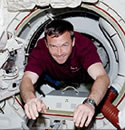
Image credit: NASA
A Russian-Belgian crew of cosmonauts undocked from the International Space Station on Sunday and piloted their Soyuz spacecraft back to Earth and landed safely in rural Kazakhstan. During their 10-day mission in space, the cosmonauts performed a series of experiments including research into the effects of weightlessness and radiation on genes. All three crew members are reported to be in good health.
A Russian-Belgian cosmonaut crew departed the International Space Station today after delivering a new Soyuz return vehicle to the complex and conducting more than a week?s worth of joint scientific experiments with the residents on board.
Russian ?taxi crew? Commander Sergei Zalyotin, European Space Agency Flight Engineer Frank DeWinne from Belgium and Russian Flight Engineer Yuri Lonchakov undocked the Soyuz TM-34 capsule from the Zarya Control Module?s nadir docking port at 2:44 p.m. Central time (2044 GMT) and backed away from the ISS to a safe distance through a series of thruster firings. The Soyuz TM-34 vehicle arrived at the ISS in April. Left behind docked to the Russian Pirs Docking Compartment of the ISS is the new Soyuz TMA-1 return craft which carried Zalyotin, DeWinne and Lonchakov from the Baikonur Cosmodrome in Kazakhstan during their launch on Oct. 30. They arrived at the ISS on Nov. 1.
A fresh Soyuz is delivered to the ISS every six months to provide an assured return capability for station residents in the unlikely event a problem would force them to come home prematurely. The new Soyuz is designed to accommodate larger or smaller crewmembers, and is equipped with upgraded computers, a new cockpit control panel and improved avionics.
The Expedition 5 crewmembers ? Commander Valery Korzun, NASA ISS Science Officer Peggy Whitson and Flight Engineer Sergei Treschev ? bid the ?taxi? crew farewell earlier today before closing hatches between the station and the Soyuz return vehicle.
Later today, Zalyotin will perform a deorbit maneuver using the Soyuz thrusters to begin the descent back home for a landing on the steppes of Kazakhstan at 6:04 p.m. Central time (0004 GMT Nov. 10, 5:04 a.m. Kazakhstan time Nov. 10).
The departure of the ?taxi? crew sets the stage for the launch of the shuttle Endeavour on the STS-113 mission early Monday to bring a new crew of residents to the ISS to replace Korzun, Whitson and Treschev, who have been in space since June. Endeavour?s crew, led by Commander Jim Wetherbee, will also deliver the Port One (P1) truss segment to the ISS, the fourth of 11 such trusses that will form the backbone for the ISS for the addition of new modules and power-producing solar arrays.
Information on the crew’s activities, future launch dates, as well as station sighting opportunities from anywhere on the Earth, is available on the Internet at: http://spaceflight.nasa.govDetails on station science operations can be found on an Internet site administered by the Payload Operations Center at NASA’s Marshall Space Flight Center in Huntsville, Ala., at: http://www.scipoc.msfc.nasa.govThe next ISS status will be incorporated into the STS-113 mission status reports beginning after the launch of Endeavour, or sooner, if developments warrant.
Original Source: NASA News Release
Oxygen Leak Delays Launch
The launch of the space shuttle Endeavour was pushed back at least a week when engineers discovered an oxygen leak in the cabin ? only a few hours before the shuttle was scheduled to launch. The leaking oxygen transfer line is going to be hard to fix as it?s located in a hard to reach area under the payload bay. Once the shuttle does launch (now scheduled for some time between 0 and 0400 GMT on Tuesday, November 19), it will carry a replacement crew to the International Space Station.
Star Seen Very Near Black Hole
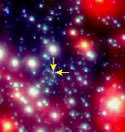
Image credit: ESO
A team of astronomers have spotted an otherwise normal star make a close pass with the supermassive black hole that lurks at the centre of our Milky Way Galaxy. At its closest approach, the star was only 17 light-hours away from the black hole (three times the distance of the Sun to Pluto). Images of the region were gathered over 10 years using the adaptive optics system on the European Southern Observatory’s Paranal Observatory.
An international team of astronomers [2], lead by researchers at the Max-Planck Institute for Extraterrestrial Physics (MPE), has directly observed an otherwise normal star orbiting the supermassive black hole at the center of the Milky Way Galaxy.
Ten years of painstaking measurements have been crowned by a series of unique images obtained by the Adaptive Optics (AO) NAOS-CONICA (NACO) instrument [3] on the 8.2-m VLT YEPUN telescope at the ESO Paranal Observatory. It turns out that earlier this year the star approached the central Black Hole to within 17 light-hours – only three times the distance between the Sun and planet Pluto – while travelling at no less than 5000 km/sec.
Previous measurements of the velocities of stars near the center of the Milky Way and variable X-ray emission from this area have provided the strongest evidence so far of the existence of a central Black Hole in our home galaxy and, implicitly, that the dark mass concentrations seen in many nuclei of other galaxies probably are also supermassive black holes. However, it has not yet been possible to exclude several alternative configurations.
In a break-through paper appearing in the research journal Nature on October 17th, 2002, the present team reports their exciting results, including high-resolution images that allow tracing two-thirds of the orbit of a star designated “S2”. It is currently the closest observable star to the compact radio source and massive black hole candidate “SgrA*” (“Sagittarius A”) at the very center of the Milky Way. The orbital period is just over 15 years.
The new measurements exclude with high confidence that the central dark mass consists of a cluster of unusual stars or elementary particles, and leave little doubt of the presence of a supermassive black hole at the centre of the galaxy in which we live.
Quasars and Black Holes
Ever since the discovery of the quasars (quasi-stellar radio sources) in 1963, astrophysicists have searched for an explanation of the energy production in these most luminous objects in the Universe. Quasars reside at the centres of galaxies, and it is believed that the enormous energy emitted by these objects is due to matter falling onto a supermassive Black Hole, releasing gravitational energy through intense radiation before that material disappears forever into the hole (in physics terminology: “passes beyond the event horizon” [4]).
To explain the prodigious energy production of quasars and other active galaxies, one needs to conjecture the presence of black holes with masses of one million to several billion times the mass of the Sun. Much evidence has been accumulating during the past years in support of the above “accreting black hole” model for quasars and other galaxies, including the detection of dark mass concentrations in their central regions.
However, an unambiguous proof requires excluding all possible other, non-black hole configurations of the central mass concentration. For this, it is imperative to determine the shape of the gravitational field very close to the central object – and this is not possible for the distant quasars due to technological limitations of the currently available telescopes.
The centre of the Milky Way
The centre of our Milky Way galaxy is located in the southern constallation Sagittarius (The Archer) and is “only” 26,000 light-years away [5]. On high-resolution images, it is possible to discern thousands of individual stars within the central, one light-year wide region (this corresponds to about one-quarter of the distance to “Proxima Centauri”, the star nearest to the solar system).
Using the motions of these stars to probe the gravitational field, observations with the 3.5-m New Technology Telescope (NTT) at the ESO La Silla Observatory (Chile) (and subsequently at the 10-m Keck telescope, Hawaii, USA) over the last decade have shown that a mass of about 3 million times that of the Sun is concentrated within a radius of only 10 light-days [5] of the compact radio and X-ray source SgrA* (“Sagittarius A”) at the center of the star cluster.
This means that SgrA* is the most likely counterpart of the putative black hole and, at the same time, it makes the Galactic Center the best piece of evidence for the existence of such supermassive black holes. However, those earlier investigations could not exclude several other, non-black hole configurations.
“We then needed even sharper images to settle the issue of whether any configuration other than a black hole is possible and we counted on the ESO VLT telescope to provide those”, explains Reinhard Genzel, Director at the Max-Planck Institute for Extraterrestrial Physics (MPE) in Garching near Munich (Germany) and member of the present team. “The new NAOS-CONICA (NACO) instrument, built in a close collaboration between our institute, the Max-Planck Institute for Astronomy (MPIA: Heidelberg, Germany), ESO and the Paris-Meudon and Grenoble Observatories (France), was just what we needed to take this decisive step forward”.
The NACO observations of the Milky Way centre
The new NACO instrument [3] was installed in late 2001 at the VLT 8.2-m YEPUN telescope. Already during the initial tests, it produced many impressive images, some of which have been the subject of earlier ESO press releases [6].
“The first observations this year with NACO gave us right away the sharpest and ‘deepest’ images of the Milky Way Centre ever taken, showing a large number of stars in that area in great detail”, says Andreas Eckart of the University of Cologne, another member of the international team that is headed by Rainer Sch?del, Thomas Ott and Reinhard Genzel from MPE. “But we were still to be overwhelmed by the wonderful outcome of those data!”
Combining their infrared images with high-resolution radio data, the team was able to determine – during a ten-year period – very accurate positions of about one thousand stars in the central area with respect to the compact radio source SgrA*, see PR Photo 23c/02.
“When we included the latest NACO data in our analysis in May 2002, we could not believe our eyes. The star S2, which is the one currently closest to SgrA*, had just performed a rapid swing-by near the radio source. We suddenly realised that we were actually witnessing the motion of a star in orbit around the central black hole, taking it incredibly close to that mysterious object”, says a very happy Thomas Ott, who is now working in the MPE team on his PhD thesis.
In orbit around the central black hole
No event like this one has ever been recorded. These unique data show unambiguously that S2 is moving along an elliptical orbit with SgrA* at one focus, i.e. S2 orbits SgrA* like the Earth orbits the Sun, cf. the right panel of PR Photo 23c/02.
The superb data also allow a precise determination of the orbital parameters (shape, size, etc.). It turns out that S2 reached its closest distance to SgrA* in the spring of 2002, at which moment it was only 17 light-hours [5] away from the radio source, or just 3 times the Sun-Pluto distance. It was then moving at more than 5000 km/s, or nearly two hundred times the speed of the Earth in its orbit around the Sun. The orbital period is 15.2 years. The orbit is rather elongated – the eccentricity is 0.87 – indicating that S2 is about 10 light-days away from the central mass at the most distant orbital point [7].
“We are now able to demonstrate with certainty that SgrA* is indeed the location of the central dark mass we knew existed. Even more important, our new data have “shrunk” by a factor of several thousand the volume within which those several million solar masses are contained”, says Rainer Sch?del, PhD student at MPE and also first author of the resulting paper.
In fact, model calculations now indicate that the best estimate of the mass of the Black Hole at the centre of the Milky Way is 2.6 ? 0.2 million times the mass of the Sun.
No other possibilities
According to the detailed analysis presented in the Nature article, other previously possible configurations, such as very compact clusters of neutron stars, stellar size black holes or low mass stars, or even a ball of putative heavy neutrinos, can now be definitively excluded.
The only still viable non-black hole configuration is a hypothetical star of heavy elementary particles called bosons, which would look very similar to a black hole. “However”, says Reinhard Genzel, “even if such a boson star is in principle possible, it would rapidly collapse into a supermassive black hole anyhow, so I think we have pretty much clinched the case!”
Next observations
“Most astrophysicists would accept that the new data provide compelling evidence that a supermassive black hole exists in the center of the Milky Way. This makes even more likely the supermassive black hole interpretation for the enormous concentration of dark mass detected at the center of many other galaxies”, says Alvio Renzini, VLT Programme Scientist at ESO.
So what remains to be done? The next big quest now is to understand when and how these supermassive black holes formed and why almost every massive galaxy appears to contain one. The formation of central black holes and that of their host galaxies themselves increasingly appear to be just one problem and the same. Indeed, one of the outstanding challenges for the VLT to solve in the next few years.
There is also little doubt that coming interferometric observations with instruments at the VLT Interferometer (VLTI) and the Large Binocular Telescope (LBT) will also result in another giant leap within this exciting field of research.
Andreas Eckart is optimistic: “Perhaps it will even be possible with X-ray and radio observations in the next few years to directly demonstrate the existence of the event horizon.”
Original Source: ESO News Release
Comet Chasing Spacecraft Delivered to Spaceport
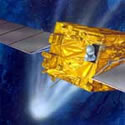
Image credit: ESA
The European Space Agency’s Rosetta spacecraft was shipped to the Kourou spaceport in French Guiana in preparation for its launch early next year. The spacecraft contains 20 different scientific instruments designed to help study comets. It will lift off January 13, and then spend nine years in space; hurtling past two asteroids, Mars, Earth twice and finally arrive at comet Wirtanen. It will approach the comet and get as close as one kilometre.
Twenty instruments on the European Space Agency’s comet-chasing Rosetta spacecraft, including three from NASA, are in final tests for launch early next year.
Launch from the Kourou spaceport in French Guiana, on the northeastern coast of South America, is scheduled for a 19-day window beginning Jan. 13, 2003. Shipment to Kourou last month from the European Space Research and Technology Centre in Noordwijk, the Netherlands, followed more than 10 months of rigorous testing. “With the move from Europe to Kourou, we have now entered the most exciting phase of the Rosetta program so far — the launch campaign,” said Claude Berner, Rosetta’s payload and assembly, integration and verification manager.
NASA is funding three research instruments and a key part of a fourth for the collaborative mission. NASA also provides one of the Rosetta’s interdisciplinary scientists, Dr. Paul Weissman, of NASA’s Jet Propulsion Laboratory, Pasadena, Calif., and operational support from JPL’s Deep Space Network of ground-based antennas. “Rosetta is an ambitious mission with great international cooperation,” said JPL’s Dr. Claudia Alexander, project scientist for the U.S. role in the mission. “We’re eager to get it launched.”
Rosetta will fly for nearly nine years, passing by two asteroids, by Earth twice and by Mars before reaching its destination, comet Wirtanen, in November 2011. At that point, the comet will be about four times as far from the Sun as Earth is. Then, as Rosetta orbits Wirtanen at distances as close as one kilometer (0.6 mile), the orbiter’s instruments will examine how the comet changes while it moves closer to the Sun during the following 20 months. Rosetta will also drop a lander onto the surface of Wirtanen’s icy nucleus. The NASA instruments will examine Wirtanen from the orbiter. International teams of scientists expect to see dramatic changes as the comet approaches the Sun. Gases and dust escaping from the surface of a comet form a cloud-like “coma” around the nucleus and a tail pointing away from the Sun.
Rosetta carries more instruments than any other spacecraft in history. The orbiter’s payload includes a camera to study surface details, a microscope to analyze dust grains coming off the nucleus, spectrometers to examine surface and coma materials in various wavelengths, and an experiment to probe the comet’s interior with radio waves.
With all instruments installed, the spacecraft was put through its paces during testing at the European Space Research and Technology Centre. It was placed in a large vacuum chamber while the instruments were tested in heat and cold simulating the extremes the spacecraft will experience when it is closest to the Sun and when it will be almost as distant as Jupiter. Vibration and acoustic tests demonstrated that the whole spacecraft can survive a launch environment. Another set of tests checked whether any instruments cause electromagnetic interference with any others. Verification of many essential functions included commanding the spacecraft from the European Space Operations Centre in Germany, just as it will be in orbit. At Kourou, each instrument will again be tested by itself and with the other instruments before engineers can finally declare everything “green” for launch.
JPL supplied the Microwave Instrument for Rosetta Orbiter, the first of its type for any interplanetary mission. This instrument can reveal the abundances of selected gases, their temperatures, the speed at which they’re coming off the nucleus, and the temperature of the nucleus. Scientists will use it to monitor changes in how vapors are released from the nucleus as the coma and tail grow. They will be studying water, carbon monoxide, ammonia and methanol gases, four of the most abundant gases from comets. JPL’s Dr. Samuel Gulkis is principal investigator.
The Southwest Research Institute, based in San Antonio, Texas, supplied two NASA instruments for Rosetta. One is named Alice. It is the first in a new generation of miniaturized ultraviolet spectrometers and is capable of analyzing the composition both of gases released by the comet and of the comet’s surface. One goal of scientists using it will be to learn about the temperatures at which the comet formed and evolved by determining its abundances of noble gases, such as helium, neon and argon. Principal investigator for the ultraviolet instrument is Dr. Alan Stern of the institute’s Space Studies Department in Boulder, Colo.
Dr. James Burch, of the institute’s Instrumentation and Space Research Division, San Antonio, is principal investigator for Rosetta’s Ion and Electron Spectrometer. This device will measure the environment of charged particles surrounding comet Wirtanen. It will also study the interaction between that environment and the solar wind of charged particles speeding outward from the Sun.
Key electronics for a fourth instrument, the Rosetta Orbiter Spectrometer for Ion and Neutral Analysis, have been supplied by the Lockheed Martin Advanced Technology Center, Palo Alto, Calif. This instrument will examine gases surrounding the comet.
Information is available about Rosetta at http://sci.esa.int/rosetta and about the microwave instrument at http://mirowww.jpl.nasa.gov. JPL, a division of the California Institute of Technology in Pasadena, manages the microwave instrument for NASA’s Office of Space Science, Washington, D.C.
Original Source: NASA News Release
Asteroid Found to Match Earth’s Orbit
Astronomers have discovered an asteroid in a companion orbit to the Earth. Named 2002 AA29, this 100 metre asteroid was discovered by the linear automated sky survey project in January. Although objects have been found to share the orbits of other planets, none have ever been found for the Earth. You don’t have to worry about it hitting the planet, though, as calculations of its orbit have determined that 2002 AA29 will never come closer than 4.5 million kilometres (12 times the distance from the Earth to the moon).
Atlantis Lands Safely at KSC
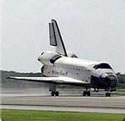
Image credit: NASA
Thanks in part to perfect weather, the space shuttle Atlantis touched down safely on Friday at the Kennedy Space Center. During their 11 days in space, the astronaut crew performed three spacewalks to successfully install the S1 truss to the International Space Station. The next mission to the ISS will be a Soyuz taxi flight, followed shortly by the space shuttle Endeavour; tentatively scheduled to launch November 10th.
Space Shuttle Atlantis glided to a noontime landing at the Kennedy Space Center in Florida completing a 4.5 million mile journey to outfit the International Space Station with a new section of truss and supplies for the Expedition crew onboard.
With weather of little concern today, Commander Jeff Ashby piloted the shuttle to its 60th landing at KSC at 10:44 a.m. CDT. The deorbit burn occurred an hour earlier as Atlantis flew high above the southwestern Indian Ocean, dropping the shuttle out of orbit for the high-speed reentry and landing.
Atlantis’ ground track carried it above Central America and western Cuba before crossing the west coast of Florida south of Tampa. Ashby took over manual control of Atlantis at an altitude of 50,000 feet, guiding the 200,000 pound shuttle through a 290-degree right turn to line up with Runway 33.
Meanwhile, aboard the International Space Station, the Expedition Five crew was able to watch Atlantis’ safe landing while the three crewmembers continue to unpack and stow supplies delivered by the shuttle crew. Commander Valery Korzun, NASA ISS Science Officer Peggy Whitson and Cosmonaut Sergei Treschev are in their 135th day in space (133rd aboard the station).
Their next visitors are the three members of a Soyuz Taxi Crew scheduled to deliver a fresh rescue spacecraft to the station later this month. Expedition Five’s ride home will be aboard Endeavour scheduled to launch no earlier than Nov. 10 bringing another truss segment and the Expedition Six crew.
Atlantis will be hauled into its hangar later today to begin preparations for its next mission to the station in March 2003 on the STS-114 mission.
Atlantis’ six crewmembers are expected to hold a news conference at about 4 p.m. today on NASA Television and plan to return to the Johnson Space Center in Houston Saturday at about 5:30 p.m. That time is subject to change.
The next ISS status report will be issued next Friday, Oct. 25, or as events warrant.
Original Source: NASA News Release
Rocket Explosion Kills Russian Soldier
A Russian soldier was killed on Tuesday by raining debris when a Soyuz-U rocket exploded 29 seconds after launch from the Plesetsk launch facility – eight other soldiers were also injured in the accident. The cause of the explosion is still unknown, but it’s unusual considering the reliability of the Soyuz vehicle. This launch failure could push back a schedule taxi mission on October 27 if the agency decides to inspect all Soyuz spacecraft.
